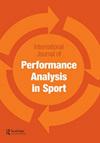在精英橄榄球七人制裁判中,裁判的位置,而不是比赛要求,得分差异或场地位置,与崩溃决策的准确性有关
IF 1.6
4区 教育学
Q1 Health Professions
International Journal of Performance Analysis in Sport
Pub Date : 2021-09-29
DOI:10.1080/24748668.2021.1979824
引用次数: 3
摘要
摘要:本研究量化了一场精英橄榄球七人赛中橄榄球裁判的决策准确性,考察了决策准确性是否随时间而变化,以及是否与比赛需求、比分差异、场地位置和裁判定位有关。在全国七人制锦标赛(6名裁判,22场比赛)期间,使用602次故障的视频编码分析决策准确性,并使用GNSS技术和心率记录检查比赛需求。总的来说,裁判的决策准确率为88.2%,没有随时间变化(p < 0.05)。比赛要求、得分差异或场地位置与决策准确性之间无显著相关性(均p < 0.05)。然而,当裁判处于次优位置时(29.0%)比处于最佳位置时(10.9%)发生的错误判罚明显更多(p < 0.05)。研究结果表明,在精英橄榄球七人制锦标赛中,裁判在崩溃过程中的决策准确性相对一致。在不受比赛需求、比分差异或场地位置影响的情况下,裁判员可以通过优化他们在崩溃时的位置来提高决策的准确性。本文章由计算机程序翻译,如有差异,请以英文原文为准。
Referee positioning, but not match demands, score difference, or field location, are associated with breakdown decision-making accuracy in elite rugby sevens referees
ABSTRACT This study quantified rugby referees’ decision-making accuracy at the breakdown in an elite rugby sevens tournament, examining whether decision-making accuracy differed over time, and if it was associated with match demands, score difference, field location, and referee positioning. During the National Sevens Tournament (six referees, 22 matches), decision-making accuracy was analysed using video coding from 602 breakdowns and match demands were examined using GNSS technology and heart rate recordings. Overall, the referees had a decision-making accuracy of 88.2% with no changes over time (all p > 0.05). There were no significant associations between match demands, score difference, or field location and decision-making accuracy (all p > 0.05). However, significantly more incorrect decisions occurred when the referees were in a suboptimal position (29.0%) compared to an optimal position (10.9%) at the breakdown (p < 0.05). The findings suggest that referees’ decision-making accuracy during the breakdown remains relatively consistent across an elite rugby sevens tournament. While unaffected by match demands, score difference or field location, referees’ decision-making accuracy may be improved by optimising their positioning at the breakdown.
求助全文
通过发布文献求助,成功后即可免费获取论文全文。
去求助
来源期刊

International Journal of Performance Analysis in Sport
SPORT SCIENCES-
CiteScore
4.70
自引率
4.80%
发文量
38
审稿时长
>12 weeks
期刊介绍:
The International Journal of Performance Analysis in Sport aims to present current original research into sports performance. In so doing, the journal contributes to our general knowledge of sports performance making findings available to a wide audience of academics and practitioners.
 求助内容:
求助内容: 应助结果提醒方式:
应助结果提醒方式:


